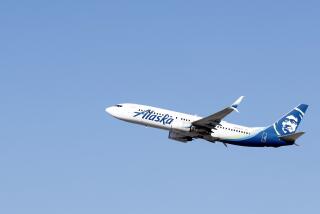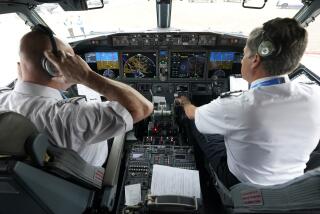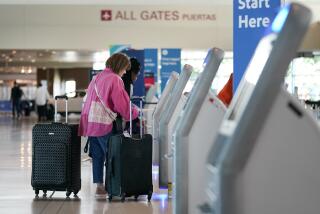TRANSPORTATION : Ideas on Improving Air Safety Focus on Human Component
WASHINGTON — Looking to improve on an air safety record that is already outstanding, the U.S. aviation community has decided to focus on the human factor. Do pilots have as much training as they need? Do they suffer from fatigue, which might impair their ability to make the right decisions in a split second?
Chastened by four major crashes in recent months--principally accidents involving commuter aircraft--the airline industry is looking for ways to make the world’s most heavily traveled air system better. Executives believe the traveling public needs and wants reassurance.
Airlines in the United States carry 500 million passengers a year, more than all other countries combined. By far, it is the safest system. But Transportation Secretary Federico Pena wants a “zero” accident rate.
He called a conference this week for 1,000 airline executives, safety experts, pilots and manufacturers. The group endorsed the “zero” goal and developed some specific suggestions for reaching it.
According to many participants, the American knack for developing technological answers is not the priority now. Rather, they suggested more emphasis on how to enhance human performance in the air and on the ground.
In spite of advanced technology--which has prevented countless crashes in recent years--human error still is involved in about 70% of all aircraft accidents, conferees were told.
Rep. James L. Oberstar (D-Minn.), ranking minority member and former chairman of the House Public Works and Transportation Committee’s aviation subcommittee, said the industry should finance additional pilot training. Particularly needed, he said, is weather training in the detection of air turbulence hazards, such as wind shears and micro-bursts.
Oberstar quoted a veteran pilot as telling him: “You may experience wind shear once in a 30-year career, but you have only a second to respond. If you’re not trained for it, you can expect a catastrophe.”
Pena cited crew training, among other areas, in saying that the Federal Aviation Administration soon will impose stricter standards on commuter airlines to bring them up to the safety level of larger carriers.
Pena announced his intention to call the safety conference last month after the Dec. 13 crash of an American Eagle Jetstream Super 31 as it approached Raleigh-Durham International Airport in North Carolina. Fifteen of 20 people aboard were killed. It marked the second crash of a commuter aircraft in less than two months, after an Oct. 31 accident in Indiana in which 68 people died.
Randolph Babbitt, president of the Air Line Pilots Assn., agreed that government regulators and industry executives need to move forward on more training for air crews. He said the training should be done in simulators for the specific aircraft involved.
When some airline executives asked FAA Administrator David R. Hinson what initiative would have the most immediate impact on air safety, Hinson said he replied: “Training, training, training.” Such training should include how pilots and air traffic controllers can better communicate to reduce the threat of accidents in flight and on taxiways, he said.
Leaders of other unions representing pilots said that the FAA should adopt regulations to ensure that air crews are rested for flights.
Current federal regulations say commuter airline pilots may fly 34 hours a week or a maximum of 120 hours a month. However, the rules governing pilots for major airlines are more strict: only 30 hours a week and no more than 100 hours a month.
The differences developed when most commuter airlines were air taxi services that carried few passengers, and federal regulators felt they could have more leeway on hours flown. But now, as commuter airlines carrying larger loads come under new scrutiny, the FAA is moving to upgrade their pilot training and other safety rules.
More to Read
Inside the business of entertainment
The Wide Shot brings you news, analysis and insights on everything from streaming wars to production — and what it all means for the future.
You may occasionally receive promotional content from the Los Angeles Times.










